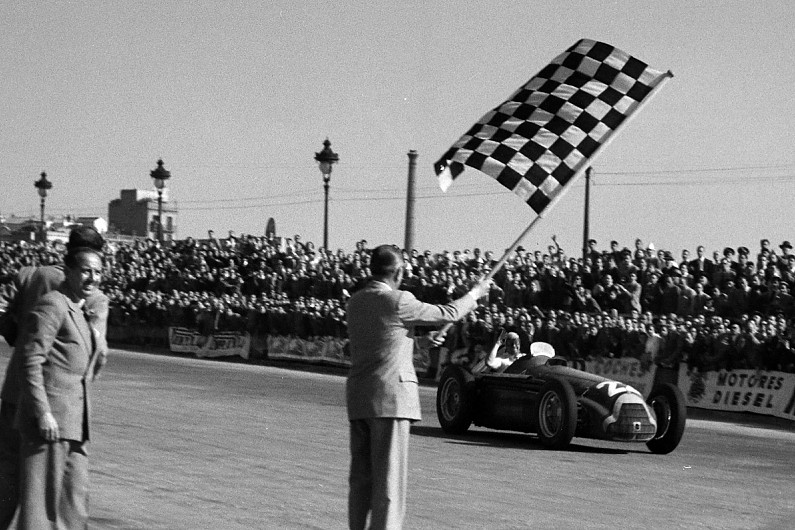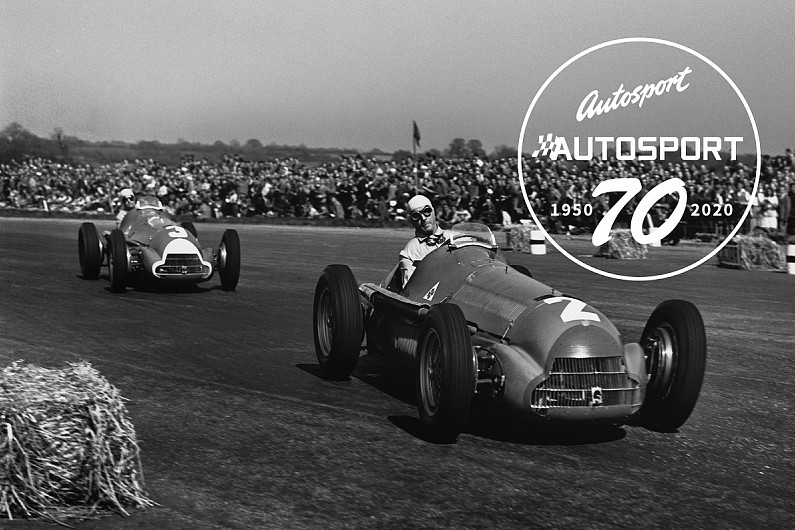Autosport’s third issue, published on 8 September 1950, focused on the dominant car in post-World War Two grand prix racing, the Alfa Romeo 158. NORMAN SMITH told its story.
During the 1937 motor racing season when the Alfa Romeo cars raced by the Scuderia Ferrari were being trounced by Mercedes-Benz and Auto Union, rumour first announced that the famous Milanese factory intended to build a 1.5-litre machine, in a desperate effort to recapture some of their, and Italy’s, vanishing prestige in the sphere of motor racing.
However, as month succeeded month no new 1500cc Alfa Romeo appeared on the scene. Despite this, odd snippets of news created the feeling that Alfa was ‘up to something’ for varying sources confirmed that new vehicles had any number of cylinders, from six to 16. This peculiar fog of uncertainty surrounding Alfa Romeo was not unusual, as only a mere five years earlier the birth and growth of Germany’s new racers had been equally obscure.
The first real clue to anything definite came in June 1938, when the British motoring press revealed that Attilio Marinoni, head tester and mechanic of Scuderia Ferrari, had thoroughly tried out the new 1.5-litre Alfa Romeo and that it proved to be an eminently satisfactory motor car.
Barely had the news sunk in before three dull red 1.5-litre Alfa Romeos stood on the starting line in the annual curtain-raising voiturette [very roughly equivalent to today’s F2] race at Leghorn on 31 July 1938, with drivers Emilio Villoresi (brother of the volatile Gigi), Francesco Severi and Clemente Biondetti.
The field consisted of the inevitable swarms of miscellaneous privately owned Maseratis, plus a works Maserati team led by Luigi ‘Gigi’ Villoresi, who as always, set off as if all the fiends in Hades were chasing him, and with his brother just astern.
The dice was a brief one; a mere 99 miles as by half distance Emilio had taken the lead, after which brother Gigi fell by the wayside, letting the new Alfa Romeo run on to an easy victory with Emilio first and Biondetti second, 2.8 seconds apart.
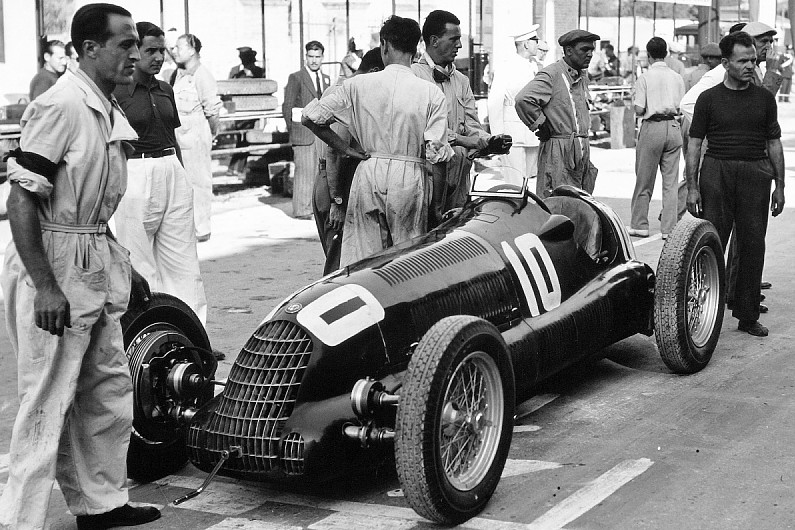
Such an initial victory was not exactly usual in the gruelling intensity of motor racing, and it aroused the greatest enthusiasm throughout Italy. But success is a heady tonic and thus it was a tremendous shock when a fortnight later at Pescara, in the Coppa Acerbo, the little Alfettes, as they were immediately dubbed by the press, failed dismally; only Severi getting through to the finish. Plugs were blamed for this debacle, although Severi’s car, when going well, covered a timed kilometre at 141.48mph, a speed as good as any 1500cc road racing machine had ever achieved up to that time.
Their third appearance was at Monza on 11 September, when a team of three cars raced in the 175km Prix de Milan held before the Italian Grand Prix. This time the drivers were E Villoresi, Severi and Raymond Sommer the French ace, and for the second time they defeated the Maserati opposition, victory going to Villoresi, with Severi second. Sommer was in trouble, although he made the fastest lap at 96.16mph. Villoresi’s winning speed was 91.71mph and once again Monza kept up its ill-fated reputation, Aldo Marazza (Maserati), a very promising young driver, crashed with fatal results.
Alfa had a nasty setback when E Villoresi, seemingly a brainier driver than his brother, killed himself when engaged in testing at Monza
Finally in 1938, the new small Alfa ran in a minor Italian street race when surprisingly all the team retired. Thus ended 1938’s racing for the Alfettes and during the winter months, work proceeded on the machine to fit it for the major Italian races, which in view of Germany’s GP supremacy had been converted to 1500cc battles, beginning with the Tripoli GP in North Africa.
High hopes were held that the 1938 cars would be sold to British drivers at one time, but it was not to be, and when at last the cars assembled at Tripoli the Alfetta was outwardly unchanged, though it now had an official designation, the Type 158. Thirty cars started, six Alfa Romeos, three works and 19 independent Maseratis, plus two sensational Mercedes, hot off the drawing board. No one credited the Germans with much chance and an Alfa Romeo victory was supposed to be a foregone conclusion.
Imagine the consternation then, when Hermann Lang and Rudolf Caracciola simply walked away with the race in a history-making drive that will forever remain an epic. The 158 stayed well in the picture at first, Giuseppe Farina lying second, but by 10 laps (one-third distance), he was out and Alfa’s bolt was shot. Eventually only E Villoresi finished, in third behind the two flying Mercedes. Before they raced again Alfa had a nasty setback when E Villoresi (below left), seemingly a brainier driver than his brother (below centre), killed himself when engaged in testing at Monza.
Two big Italian races at Leghorn and Pescara, the Coppa Ciano and the Coppa Acerbo, both 1500cc events, were only briefly reported in England. However, the 158 ran in both of them, battling with the then new 16-valve, four-cylinder Type 4CL Maseratis. As usual the Coppa Ciano came first, victory going to Farina. He won by a lap from Franco Cortese (Maserati), with Biondetti/Carlo Maria Pintacuda third and Severi (below right)/Biondetti fifth. Fourteen days later, on the other side of Italy, they very convincingly finished 1-2-3 at Pescara – Biondetti, Pintacuda and Farina in that order – the leader averaging a record 80mph for the 1.5-litre class.
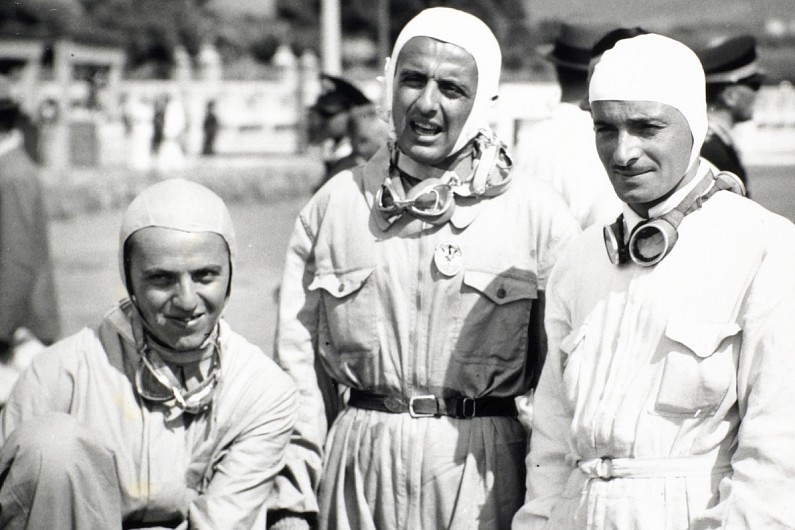
No photographs to this writer’s knowledge were ever published in the UK of either of these two races, so what the 158 looked like is sheer guess work; for at Tripoli [in May] it ran in its 1938 outline, while at Berne in August, the car took on the form so well known today.
The 1939 Swiss meeting included heats, with 1.5-litres in one and GP cars in the other, the whole lot being mixed together in the final. Heat one, for the Prix de Berne, became at once an Alfa walkover, Farina and Biondetti being entirely out on their own, crossing the line in that order, with Farina’s average a healthy 96.9mph – a speed not surpassed by any 1.5-litre car until he himself beat it this year (1950). The second was naturally Germany’s, as was the final GP, but Farina shook everybody by his terrific pace, second on the first lap, and which eventually obtained for him seventh place.
War-time racing
War broke out on 3 September and we thought it was goodbye to motor racing for the duration. Not so the Italians for, being neutral, they planned to carry on with a full season’s racing, and they commenced with a revived new version of the Mille Miglia at Brescia.
Scheduled for 12 May 1940 was the Tripoli GP, an anticipated four-sided battle between Maserati, Auto Union, Mercedes and Alfa Romeo; the Alfa people were determined to wipe off the stigma of the 1939 defeat. Well in advance of the race a hack 158 was unmercifully thrashed round the circuit until the racing department was sure that it was really right, this practising suggesting record speeds when race day dawned.
When it did the Germans were missing. No 1.5-litre Auto Unions existed and Mercedes didn’t risk the sea passage, leaving four Alfas to face a pack of Maseratis. Farina, Carlo Felice Trossi, Biondetti and Pintacuda represented the Milanese factory, L Villoresi carrying the standard for Maserati.
From flag fall Villoresi led, before yielding to Farina on lap two. By lap seven Villoresi was again in front, and a lap later it was Farina and from then on he stayed ahead to win at the incredible average of 128.2mph for 244 miles – over 5mph faster than Lang (with the Mercedes) a year previously.
Villoresi slowly dropped back, and both Biondetti and Trossi passed him when the Maserati’s refuelling stop took nearly one minute compared to the Alfas’ 30s. In the end, the 158s captured first (Farina), second (Biondetti), third (Trossi) and fifth (Pintacuda), plus the record lap.
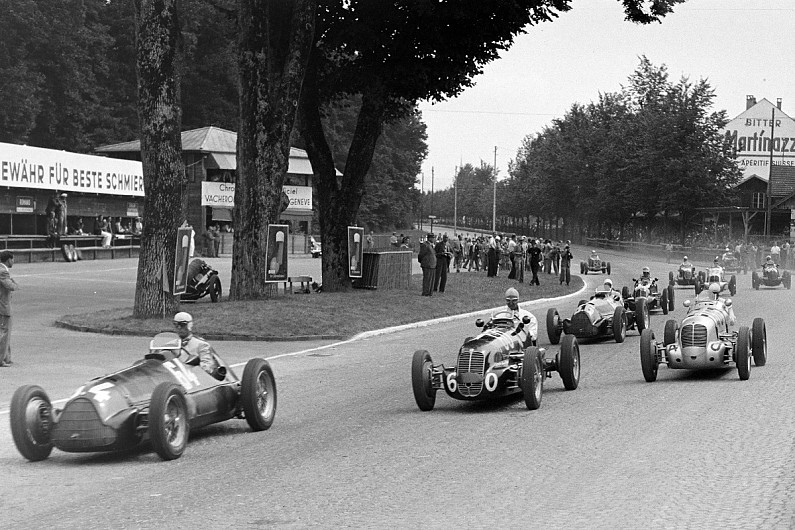
The 158 goes into cold storage
Italian entry into the war in 1940 meant the cancellation of all their racing plans, and so the 158 went into cold storage until such time as peace returned and motor racing could resume. This proved to be Easter 1946 at Nice, when the first post-war GP was held, without the Alfas. Shortly afterwards, with no fanfares, a couple of 158s were sent to St Cloud for a race there on 9 June, entrusted to pre-war stars Farina and Jean-Pierre Wimille.
Road conditions were none too good and early in the race Wimille and Farina (neither hurrying) lay first and third. As the race distance was only 112 miles it came as a surprise to find first Farina, then Wimille packing up, and with not even fastest lap to their credit. This St Cloud race was to be the last one in which Alfa Romeo 1.5-litre cars were to start and not win, right up to the point of writing.
The highlight of Reims was Wimille’s 112mph practice lap on the experimental model, the standard 158s eventually being used in the actual race, which was the usual Alfa parade; Wimille first, Sanesi second and Ascari third
Six weeks later, the little Alfas made their second post-war appearance in what was the real return of GP racing to Europe, the GP des Nations at Geneva on 21 July. Four cars were entered, with Farina, Wimille, Trossi and Achille Varzi as the drivers, and between them they collared first and second in each heat, and 1-2-3 in the final. Farina led Trossi home, with Wimille a lap in arrears due to the notorious mix-up with Tazio Nuvolari that caused quite a bit of bad feeling, and undoubtedly cost Wimille his first place.
Quartette coincidence
In 1938 and 1939 the Alfa 158 raced four times, and 1946 was to be no exception, indeed save this year [1950] the Alfettes were in action four times only every season – a strange coincidence! The other two 1946 races were the GP of Turin and the GP of Milan. At Turin the Geneva quartette did duty, but at Milan Wimille was replaced by Consalvo Sanesi, a works tester.
Both GPs were won by Alfa Romeos, with Varzi beating Wimille by 4/5ths of a second over 174 miles at Turin, Trossi doing the needful at Milan backed up by Varzi, and Sanesi third, while Farina retired in a huff. Much of his bad temper was caused his penalisation of one minute for twice jumping the start of heat two, thus making him third after he’d won it, and Sanesi, who was actually second, the winner.
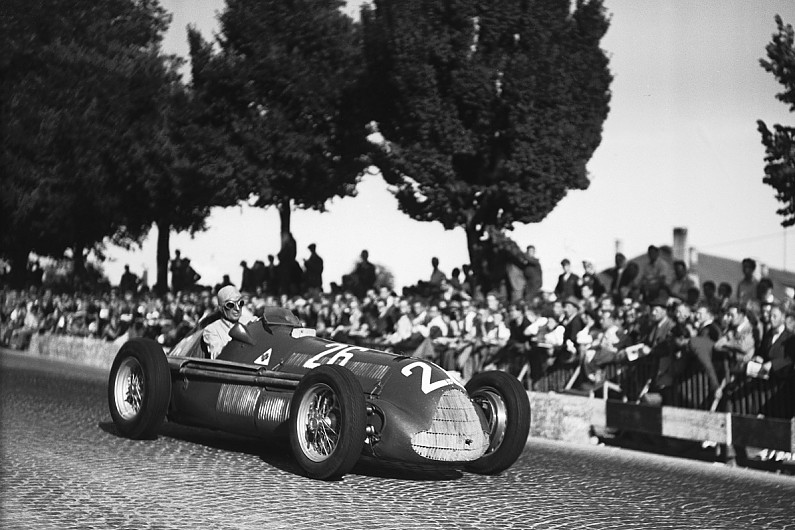
Post-war racing restarts
Racing began the following year in early April at Pau, but not until the reinstituted Swiss GP on 8 June did the Alfa Romeo team appear on the starting grid. The four pilots were Varzi, Trossi, Sanesi and Wimille, the great Jean-Pierre rejoining vice Farina after the Milan squabbling.
The story of the Swiss GP was repeated, Alfas winning both heats and final exactly as at Geneva a year earlier. Heat one went to Varzi, heat two to Wimille, who also won the final at 95.42mph from Varzi and Trossi, Sanesi being fifth one lap behind. This was the race that was marred by the unruly spectators disregarding official and police instructions, several being killed as a result.
Having started 1947 in victorious mood, the 158s went to Belgium for the GP d’Europe at Spa, where morally they had a 100% success, with 1-2-3-4. Officially it was only 1-2-3, as Sanesi was stationary at his pit effecting repairs when the race ended, and so was a non-finisher although he was comfortably ahead of the Bob Gerard/Cuth Harrison ERA that was placed fourth. Wimille won, from Varzi and Trossi, and the French ace found team control irksome, for before Varzi had some light trouble Wimille had, unauthorised, usurped the lead.
At Bari only two cars appeared for Varzi and Sanesi, but they had an easy 1-2 win from a poor field, leaving only the Italian GP to complete the four yearly races. Here on a tricky course in the Milan Fair Grounds, Wimille found himself excluded once again, his seat going to Alessandro Gaboardi. This time Count Trossi got the chequered flag ahead of Varzi, with Sanesi and Gaboardi trailing behind in third and fourth, somewhat outclassed in driving skill, but rescued by the Alfas’ superiority over their Maserati rivals.
The works racing activities in 1948 began at Berne with the Swiss GP, and with tragedy, for Varzi was killed in practice, testing an experimental model with improved performance. Only three 158s therefore started, and as in 1947 an Alfa won, Trossi being a split second in front of Wimille.
Next came the French GP at Reims, and Trossi was absent, his place going to the young Alberto Ascari, promising son of a famous father, and well he drove too. The highlight of Reims was Wimille’s 112mph practice lap on the experimental model, the standard 158s eventually being used in the actual race, which was the usual Alfa parade; Wimille first, Sanesi second and Ascari third.
Surprisingly, in the Italian GP, this year at Turin, Wimille’s car from Reims was the only Alfa to finish, the two normal cars blowing up. Wimille (below) was uncatchable, ending his race sandwiched between Villoresi and Sommer in their hectic battle for second place.
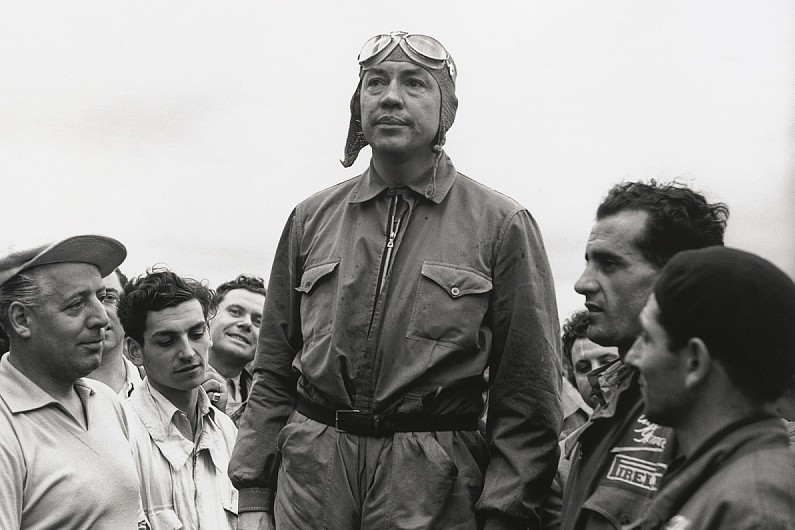
Lastly at Monza, reopened on 17 October, with a 312-mile GP ending in an Alfa Romeo victory. Wimille won at 109.98mph, in front of Trossi, Sanesi and Piero Taruffi, Sanesi for a change doing fastest lap.
After Monza, Alfa Romeo abstained from racing until May 1950, due supposedly to financial and economic considerations, though the almost complete loss of their racing team, Varzi, Wimille (killed in South America in January 1949) and Count Trossi (died in May 1949) must have influenced their decision to rest on their laurels.
1950 successes
This season’s results are too recent to warrant detailed summary, but since returning to racing the 158 has won at San Remo (Juan Manuel Fangio), Silverstone (Farina), Monaco (Fangio), Berne (Farina), Spa (Fangio), Reims (Fangio), Bari (Farina), Geneva (Fangio) and Silverstone (Farina).
The incredible fuel thirst of the highly developed supercharged 1.5-litre straight-eight Alfa engine meant more fuel stops than the Ferraris, which could by 1951 match the 159’s race pace
The latest success was at Monza, where Farina won the Italian GP; he finished over a minute ahead of Ascari in the new, 4.5-litre, unsupercharged Ferrari, with Luigi Fagioli (Alfa Romeo) in third.
That then is the brief history of the car that our own much-awaited BRM will have to tackle in the not-so-distant future. Can it beat it? We all hope so, but it will be a formidable task as this article may have indicated.
2020 hindsight
Having won every round of the inaugural world championship – except the anomalous Indianapolis 500, which it didn’t enter – Alfa Romeo started 1951 in the same fashion, with the upgraded 159. But its supremacy came increasingly under threat, not from the complex 1.5-litre supercharged BRM V16 championed by Autosport but from the unsupercharged 4.5-litre V12 Ferrari 375.
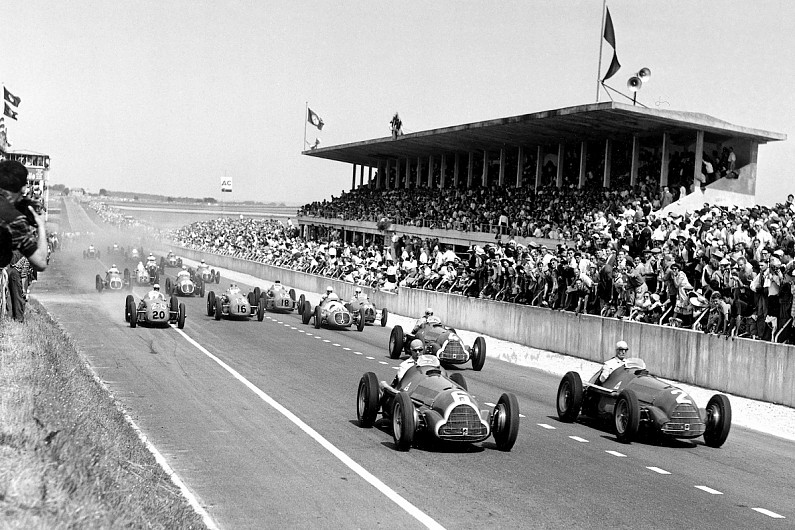
On 14 July 1951, in the British GP, Jose Froilan Gonzalez became the first person to defeat the works Alfa Romeo GP team in five years, scoring Ferrari’s first F1 world championship race victory in impressive style.
The incredible fuel thirst of the highly developed supercharged 1.5-litre straight-eight Alfa engine – as low as 1.5-2mpg! – meant more fuel stops than the Ferraris, which could now match the 159’s race pace. Ascari followed Gonzalez’s Silverstone breakthrough by winning the German and Italian GPs.
A Ferrari debacle thanks to a change of wheel specification at the title-deciding Spanish GP helped Fangio take victory and his first drivers’ crown, but the writing was on the wall. Alfa Romeo did not have the funds to develop a new machine, so pulled out of F1, finally ending the frontline career of the incredible 158/159.
